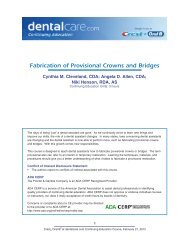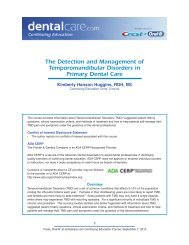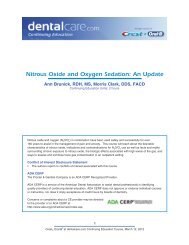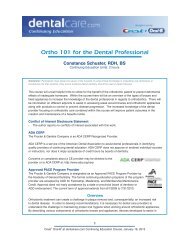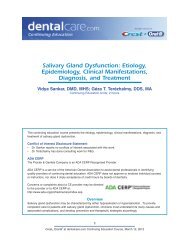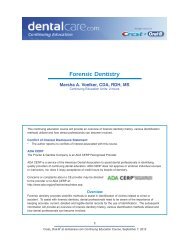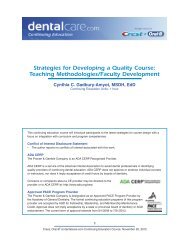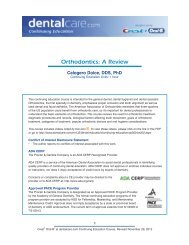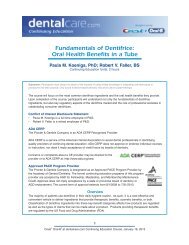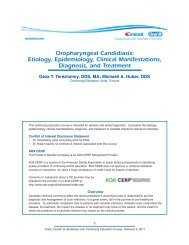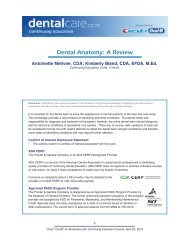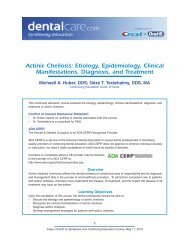CE 391 - Management of Pediatric Medical ... - DentalCare.com
CE 391 - Management of Pediatric Medical ... - DentalCare.com
CE 391 - Management of Pediatric Medical ... - DentalCare.com
You also want an ePaper? Increase the reach of your titles
YUMPU automatically turns print PDFs into web optimized ePapers that Google loves.
Table 4. Maximum Re<strong>com</strong>mended Dosage <strong>of</strong> Local Anesthetic Agents<br />
<strong>of</strong> anesthesia by allowing the local anesthesia to<br />
remain around the nerve for a longer period <strong>of</strong> time.<br />
If too much vasoconstrictor is injected or the<br />
anesthetic is injected intravascularly, the<br />
vasoconstrictor is absorbed into the vascular<br />
system just as the anesthetic. Overuse <strong>of</strong><br />
gingival retraction cord, especially in patients with<br />
a history <strong>of</strong> cardiovascular disease can cause<br />
vasoconstrictor toxicity. Increased vasoconstrictor<br />
into the blood stream causes moderate increases<br />
in systolic and diastolic blood pressures, cardiac<br />
output and stroke volume. These actions lead to<br />
an overall decrease in cardiac efficiency.<br />
After reviewing the pre-operative medical history,<br />
the vasoconstrictor use should be avoided or<br />
minimized in:<br />
• Patients with a blood pressure in excess <strong>of</strong> 200<br />
mm Hg systolic or 115 mm Hg diastolic.<br />
• Patients with uncontrolled hyperthyroidism.<br />
• Patients with severe cardiovascular disease.<br />
Less than 6 months after myocardial<br />
infarction, post-coronary bypass surgery or<br />
cerebrovascular incident.<br />
Daily episodes <strong>of</strong> angina pectoris.<br />
Cardiac dysrhythmias<br />
• Patients receiving halogenated general<br />
anesthetic agents.<br />
• Patients receiving nonspecific β-blockers, MAO<br />
inhibitors, or tricyclic antidepressants.<br />
The signs and symptoms <strong>of</strong> vasoconstrictor toxicity<br />
are:<br />
• Anxiety<br />
• Tachycardia/palpitations<br />
13<br />
• Restlessness<br />
• Headache<br />
• Tachypnea (abnormal rapid breathing)<br />
• Chest pain<br />
• Cardiac arrest<br />
Emergency <strong>Management</strong><br />
Should a patient experience vasoconstrictor toxicity,<br />
the following steps should be taken:<br />
• Stop treatment<br />
• Reassure the patient<br />
• Assess and support airway, breathing and<br />
circulation<br />
• Administer oxygen<br />
• Monitor vital signs<br />
• Contact EMS<br />
Diabetes Mellitus – Hyperglycemia/Hypoglycemia<br />
Diabetes mellitus is a disorder characterized by<br />
inadequate insulin production by the pancreas<br />
leading to <strong>com</strong>promised carbohydrate, fat and<br />
protein metabolism. If untreated, it leads to<br />
hyperglycemia (increased blood glucose levels).<br />
The most <strong>com</strong>mon type <strong>of</strong> diabetes in children is<br />
Type I diabetes (juvenile diabetes). There is little or<br />
no pancreatic β cell function and thus daily injections<br />
<strong>of</strong> insulin are required. Blood glucose levels are<br />
difficult to control leading to emergencies involving<br />
hyperglycemia or hypoglycemia (decreased blood<br />
glucose levels).<br />
In hyperglycemia, blood glucose levels are<br />
extremely elevated due to low or absent plasma<br />
insulin levels for a long period <strong>of</strong> time. Because <strong>of</strong><br />
the absence <strong>of</strong> insulin, glucose cannot enter cells,<br />
forcing the cells to metabolize fat and proteins to<br />
Crest ® Oral-B ®<br />
at dentalcare.<strong>com</strong> Continuing Education Course, May 11, 2012



